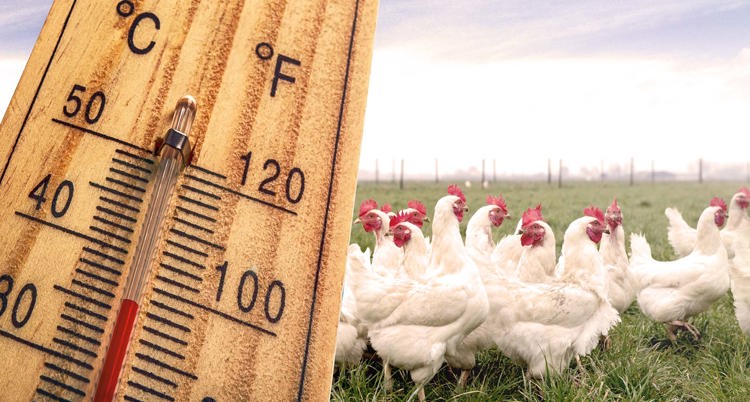Heat stress, an annual issue
When the summer comes around, it brings with it the same issues every year: hot days that cause heat stress in production animals. That, and the question whether the animals require additional support through their diet. But what is actually going on inside the animals when they are subjected to heat stress, and what can be done to alleviate it?

Animals can be helped to better deal with heat stress through adjustments in management, especially with regard to ventilation, and through their diet. Adjusting the barn climate can have an effect equal to a 10°C decrease in temperature. The effect that can be achieved through the animals’ feed is more supportive in nature, and its effect extends to approximately 1°C – a small but important difference. In this article, we will discuss the possibilities for additional support through feed. Heat stress occurs when animals are insufficiently able to expel their body heat into the environment and their metabolism is disrupted as a result. The combination of temperature and humidity determines the severity of heat stress. Animals first attempt to lose additional heat by breathing more rapidly (penting), increasing their contact surface with their environment as much as possible, and (if possible) moving to a cooler location. If these measures are not enough, the next step is a decrease in feed consumption. Thanks to the advances in breeding, animals are able to produce more per day, but this also means that they produce more heat, and are therefore more vulnerable to heat stress.
As long as the temperature falls within the thermoneutral zone, no heat stress occurs. When the temperature rises above this comfort zone and animals start to pant in order to get rid of heat, they breathe out more moisture and CO2, causing a decrease of hydrogen ions in the blood, which increases the blood pH (this is called respiratory alkalosis; see Figure 1). The body can partially compensate for this in certain ways, such as by releasing hydrogen bound to hemoglobin in return for potassium.
Consequnces of increased respiratory rate
- Reduction of blood CO2 level
- Increase of blood pH
- Minimal excretion of H+ in urine
- Increased loss of Na+ and K+ minerals
- Reduced osmotic concentration of the cells
- Dehydration
- Oxidation of muscles
- Death
Among others, this has negative consequences for:
- (re)production
- meat quality
- eggshell quality
- growth
- feedconversion ratio (FCR)
Based on our own research and experience around the world, Koudijs has developed HeatStop. HeatStop replenishes the electrolytes that an animal has lost due to heat stress. HeatStop supports the physiological processes in the animal to maximally prevent the damage caused by heat stress. Furthermore, it improves water absorption and can be preventively included in the feed in anticipation of approaching heat waves.

Fats
During hot periods, it can be useful to adjust the feed and provide more energy in the form of fats. The metabolization of fat produces less heat than carbohydrates or proteins.
Antioxidants
It also helps to add antioxidants to the feed, such as extra Vitamin E. Among other effects, Vitamin E helps limit the drop in production during heat stress. Vitamin C affects several things, including the transport of oxygen. Heat causes Vitamin C levels in the blood to decrease, necessitating replenishment via the feed.
Vitamin C helps prevent the body’s temperature from increasing too much during heat stress. Vitamin C is a very water-soluble antioxidant, while Vitamin E is fatsoluble; both are required to prevent oxidation in all parts of cells, and together they have a positive synergetic effect. Using different kinds of antioxidants together have a broader effect, and is therefore recommendable. By ensuring proper climate control in your barn and
adjusting the feed, supplemented where necessary with specific products such as HeatStop, you can help your animals cope with periods of heat stress with less discomfort.
Advantages of heatstop
- Multi-species application
- Contains active components for full body support
- Attacks heat stress from multiple angles
- Directly affects physiological processes
- Can be used preventively




